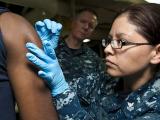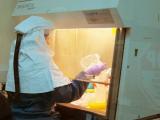Nov 12 (CIDRAP News) Improved survival among victims of the recent anthrax attacks, as compared with past anthrax cases, is probably a result of better antibiotic regimens, early recognition and treatment, and improved supportive care, among other factors, according to Centers for Disease Control and Prevention (CDC) officials.
Six of the 10 people who recently contracted inhalational anthrax have recovered or are recovering, according to a new report in the CDC journal Emerging Infectious Diseases (EID). Previous reports of the disease have indicated a survival rate of only 15%. The EID report, published online Nov 8, describes each of the 10 cases, and CDC officials discussed the report in a press conference Nov 9.
"The combination of antibiotic therapy begun during the initial phase of illness and aggressive supportive care may have markedly improved the survival rate for the recent ten patients," Bradley Perkins, MD, told reporters in the briefing.
The EID report, by John A. Jernigan and others, states, "The apparent improvement in survival compared with previous cases suggests that the antibiotic combinations used in these patients may have therapeutic advantage over previous regimens. Limited data on treatment of the survivors suggests that early treatment with a fluoroquinolone and at least one other active drug may improve survival. . . . Other explanations for the improved survival rate include earlier recognition and initiation of treatment, better supportive care, differences in the pathogenesis of bioterrorism-related anthrax, differences in susceptibility of the hosts, or a combination of the above."
The report notes that inhalational anthrax has two stages: "a 1- to 4-day initial phase of malaise, fatigue, fever, myalgias, and nonproductive cough, followed by a fulminant phase of respiratory distress, cyanosis, and diaphoresis." The six patients who survived all were in the first phase when they sought medical care and all received antibiotics on their first day of treatment. Two of the four patients who died were still in the initial phase when they presented for treatment, but they did not receive antibiotics before they entered the fulminant phase.
"The persons that did poorly or died presented for medical attention, at least at the time of admission, with more critical illness than those that surivived," said Perkins.
Before the recent anthrax attacks, only 18 cases of inhalational anthrax had occurred in the United States in the past century, the last one in 1976, the EID report says. Most cases stemmed from exposure to animal products, mainly in mills processing goat hair, goatskins, or wool.
Perkins said several supportive treatments that are now routine but were less common or nonexistent at the time of earlier anthrax cases probably helped boost the survival rate of the recent patients. These include "aggressive intravenous hydration therapy," pressor drugs that help maintain normal blood pressure, and drainage of pleural fluid, which was required in 7 of the 10 patients. "If that's not done, that obviously mechanically compresses the lung tissue and further compromises respiratory function," Perkins said.
The EID report notes that inhalational anthrax presents a diagnostic challenge because the initial phase often looks like a viral respiratory illness. All ten patients had abnormal initial chest x-rays, the report says, but Perkins commented, "The typical prodrome for these patients is typical for many respiratory diseases that physicians might not usually get a chest x-ray for. . . . It's useful information that all the chest x-rays are abnormal in these patients, but . . . in the clinical setting when you're looking at a specific patient, that information has to be balanced very carefully against the frequency of other respiratory disease."
Seven of the 10 anthrax patients were men, and their median age was 56, the EID report says. All 10 patients had pleural effusions, which often were small at the time of presentation but became large during hospitalization. Of eight patients who underwent chest computed tomography (CT), seven had mediastinal lymphadenopathy. No predominant underlying diseases were seen in the 10 patients, though four had cardiovascular or cerebrovascular disease.
"Case 2 [the patient identified in the general media as Ernesto Blanco, 73, who worked at American Media in Florida] was remarkable in that x-ray findings were dominated by large and progressive pulmonary infiltrates, not by mediastinal widening," the report says. The chest CT likewise showed no mediastinal adenopathy.
See also:
Jernigan JA, Stephens DS, Ashford DA, et al. Bioterrorism-related inhalational anthrax: the first 10 cases reported in the United States. Emerg Infect Dis 2001 Nov/Dec;7(6) [Full text]
CDC telebriefing transcript, "Update on anthrax investigations with Dr. Bradley Perkins"
http://www.cdc.gov/media/transcripts/t011109.htm




















